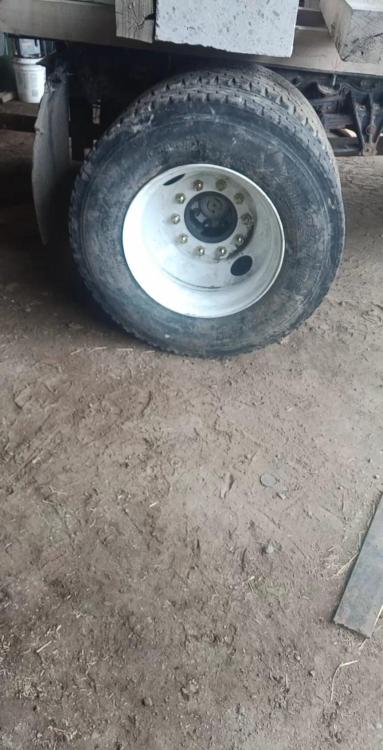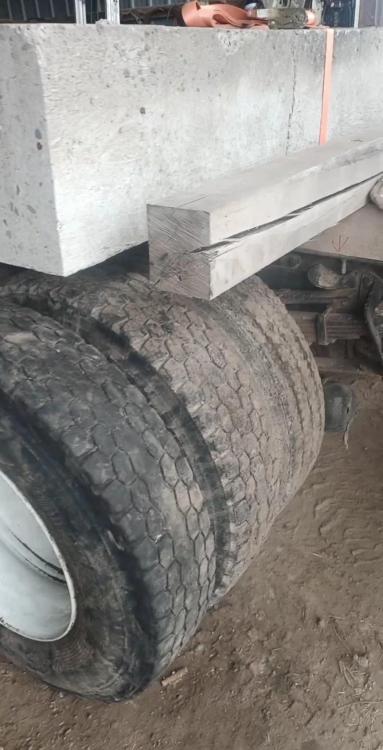
JoeH
-
Posts
2,714 -
Joined
-
Last visited
-
Days Won
18
Content Type
Profiles
Forums
Gallery
Events
Blogs
BMT Wiki
Collections
Store
Posts posted by JoeH
-
-
On 5/28/2022 at 12:48 AM, Mandrewoid said:
Here are some progress photos. Centering and squaring the plate for welding was easier than I thought, and no additional wobble was incurred. I am cutting some additional pieces for reinforcing the inside, as I agree it will put excessive stress on the edge of the center rim if too much weight is borne by the outside wheel.
I also have to make a few small blocks on the surface of the flat adapter to "hub pilot" the outside wheel, as I don't think that I want to get into the complications of special lug nuts. In this photo, the third wheel is secured by 1" bolts. I am considering the possibility of purchasing knurled studs, does anyone know where I could get 40 26mm knurled studs?
I want to know how this monster is doing! How have your third wheel adapters been working? It's been a year and a half now!
I wish I saw this thread when it started! You can run 315/80-R22.5 on 9" wide rims as dualies, no reason you shouldn't be able to run 3 across! They'll give you wider tires for more flotation.
-
Those transmission models are from my minimal experience. I have a 2003 MR688 that has the HD4560, and just picked up a front cutoff of a 2000 MR688 with the HT740.
The computerized HD4560 has a top mount PTO port as well as a driver side PTO port.
-
That's a monster of a truck!
Is the transfer case for AWD bolted to the transmission or is it a standalone unit further back? I know what you mean on finding people who can drive something other than an automatic.
If you do try to put an automatic on there then you need to do your research, and you'll need a donor truck year 2000 or older. 2000 has a cable shifted Allison HT740 mechanical (I think) transmission, with the only PTO port on the top of the transmission. By 2003 they switched to an Allison HD4560 computerized automatic.
I don't know how the automatic transmission's gear ratios will do going up those inclines, I don't think you'll be going any faster up that hill. Looking at your bumper I'm guessing the top mount PTO won't be an issue because you're running it live on the engine.
-
 2
2
-
-
I have those zip ties on all my trucks with self adjusters, and in each truck I carry a 3 inch scrap of flat bar with quarter inch gradations on it under the seat. Gives a quick reference to know where your brake adjustments are.
-
 1
1
-
-
If that checks out then note back to us the following:
With parking brake set, what angle are the push rods to the slack adjusters? Maximum braking force is at 90 degrees when fully applied.
I'd also like to know how much travel each air chamber pushrod has. To get these measurements, release brake, put a zip tie on each pushrod just barely against the face of the air chamber. Then set the parking brake, and measure how far off the chamber face the zip tie is. Measure each of the 4 drive positions and let us know what they are. You should have them set to 1 inch. 1-3/4 inch is usually maximum legal travel. Much more than that and your chamber maxes out it's travel before it has the shoe fully applied to the drum.
-
 1
1
-
-
3 minutes ago, Moparmike said:
truck stops just not how it usually stops
takes longer even empty
Does the truck pass the air pre trip? The rubber diaphragms in the service chambers do rupture, and a bad one can dump enough air pressure to cause problems.
The short of the pre trip is build air pressure, shut off truck. Listen for leaks. Release parking brake, listen for leaks. Apply service brake pedal fully, listen for leaks.
The whole while you are watching your air gauges for pressure loss.
-
 1
1
-
-
7 minutes ago, Moparmike said:
I took lines off whole truck was running to verify air pressure was there
Air moving doesn't = full air pressure.
-
8 minutes ago, Moparmike said:
biggest reason for the change was a few didn't adjust (SELF) so I just replaced all 4
all the 1s I took off was on the truck when I purchased it about 7yrs ago
and most times I try catch fleet pride deals on drum and brake kits change most stuff all at once
I hate self adjusters for exactly this reason. I put manual adjusters on my older trucks that can legally run them. A) it forces me/driver under the truck to look at things regularly, b) when you adjust them all your brakes are synchronized and the truck stops straight with no pulling, C) you dont have to worry about the self adjuster failing.
-
 1
1
-
 1
1
-
-
23 hours ago, Moparmike said:
so I'm looking things over decided to replace all slack adjuster on back with new from mack
New slack adjusters combined with indicating in one of the above quotes that you "pressed the brake to get everything adjusted back out" is a red flag to me that you might not know how to adjust the brakes properly. No offense meant, I'm just reading more thoroughly than I did my first time through.
-
23 hours ago, Moparmike said:
s cam is free not stuck when I press brake pedal it makes a noise can't remember if the noise was there before or after I slammed brakes
My R models all make a bit of a momentary farting noise in the pedal on initial brake application. I assume this is what you're referring to.
-
23 hours ago, Moparmike said:
as I'm looking things over I let air build up and press brakes to get everything adjusted back out
Reread this in original post and I'm a little confused, pressing brakes doesn't adjust them.
-
5 hours ago, Moparmike said:
brake have 2 different valves on them
and air comes out both lines when off press 1 air the other has air when you remove it
Are you saying you have air leaks? Can you clarify what you mean here? With truck fully assembled you need to run through a proper Air System PreTrip Inspection! This will find any air leaks you have that could be causing your issue!
Maybe I'm not following the thread well enough, but I don't get the impression that air leaks were checked for "by the book."
Here's a YouTube video on how to run the air system pre trip inspection.
-
IIRC on this style clutch you take out the lock tab, push the clutch pedal in, then spin the flywheel to thread the clutch tighter? Then reinstall the lock tab and you're good to go...
I may be a weee bit off though...
-
 1
1
-
-
Looks to me like 4034836, but idk. Probably a 30 or more year old clutch, don't think my dad ever put a clutch in it, and we've had the truck since I was a boy 25+ years ago.
-
Agreed that looks like a truck for Europe. No thanks on that electric monstrosity, I'd hold out for an Edison Motors repower of my old Macks.
-
 1
1
-
-
-
If the brakes aren't working I'd bring joey to the truck lol!
-
 2
2
-
-
Some truck manufacturers install a pressure gauge to tell you how much brake pressure you're applying. You can put a gauge on your system so you can see if you're getting good pressure through the foot valve. I suppose it's possible you hurt the foot valve, but I doubt it. I assume the truck has self adjusters? I think you need to be under the truck while someone else works the pedal to see if all the slack adjusters are functioning properly. Maybe you ripped one of them up internally.
Does the truck pull to one side or the other when stopping? The brakes would be working better on the side it pulls towards.
Have you run through the pre trip air system check to listen for air leaks? Maybe you ruptured an air chamber.
-
Do you have access to a helper? You need to have someone in the cab working the brake while you are under the truck. With wheels chocked of course!
-
 1
1
-
-
You could also have broken friction material off the shoes, or cracked a brake drum. When the brake drums get worn out and thinner they're easier to blow apart. But I'd expect that carnage would be obvious.
-
I'm wondering about S cams going over-center. If any brakes were close to being out of adjustment then a real hard brake application can push them far enough that the tips of the S go passed the rollers.
On all my trucks I release my brakes, put a zip tie on the pushrod right against the air chamber, then apply the parking/trolley brakes. Measure the travel of the zip tie from the reference face of the air chamber, more than 1-3/4" travel is a red flag, and that wheel needs to be adjusted. That's my redneck check my brakes myself method when I don't have a second person to work the pedal.
It is also possible to bend the bracket the brake chamber bolts to. Its a replaceable plate, you have to pull S Cam and then it's 4 bolts around the tube the S Cam goes through.
-
 1
1
-
-
I think I read on here a few years ago that you should check your coolant with a voltmeter to check it's health. I forget what settings to run and what number range to look for, but the engine coolant i tested checked out well. I guess the stuff goes bad and will cause electrolysis, which is basically what the voltmeter is testing for.
-
 1
1
-
-
-
Personally I would just get the right clutch for your existing truck. Chances are that'll be the last clutch that truck ever needs, unless you're going to be putting 1,000 hours or more on it per year.
-
 1
1
-





2000 mack rd688 brake help
in Air Systems and Brakes
Posted · Edited by JoeH
On the intermediate axle of Mack Camelbacks, the slack adjusters are mounted "backwards" I believe, so is it possible you have the new slack adjusters installed wrong? The rearmost axle adjusts normally, but the intermediate axle requires a reverse action slack adjuster. Your parts dealer should have given you two and two different adjusters, not four of the same.
When we bought my 1995 RD688S it took us a while to find out why the one wheel was always walking out of adjustment. The above is why. Previous owner installed the wrong style self adjusters. This truck now has all manual adjusters.
After a certain year, I think around 2000,2001 you're not allowed to use manual adjusters, but I think if a cop pulled you over and you explained a) brakes are all adjusted and b) synchronized I don't think he could argue with you other than if he's a complete ass and c) you know exactly where your brake lining life is at.